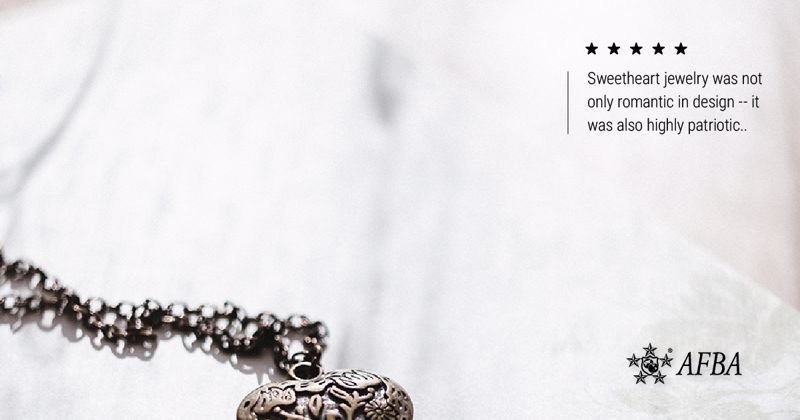In the Valentine's Day spirit, we're tracing the history of "sweetheart jewelry," which became widely popular during the Second World War.
Traditionally given by a soldier heading off to war to a loved one at home, a piece of sweetheart jewelry was both romantic and patriotic in nature. Today, these items are considered collectible pieces of our nation's past.
Sentimental jewelry to remember soldiers during times of war
As the Cooper Hewitt museum explains, the custom of gifting sweetheart jewelry dates back to World War I. However, it became even more popular during World War II, when countless couples and families were separated as soldiers left home to fight overseas.
Sweetheart jewelry was most commonly exchanged between romantic couples. But fathers, brothers and sons also left family members with these tokens in their absence. Women purchased their own sweetheart jewelry, too, either to remember a certain soldier or show support for the nation's forces as a whole.
Wherever these sentimental items came from, their owners wore them proudly and passionately. Women wore brooches to keep their family and country close to the heart. They tucked pictures of the soldiers they missed into treasured lockets and they wore their hearts on their sleeves in the form of bracelets.
Patriotic colors and imagery permeated jewelry design
While hearts were a common theme, sweetheart jewelry was not only romantic in design; it was also highly patriotic. Many of these items featured military insignia and other icons related to a loved one's branch of service. Others included the American flag or details featuring stars and stripes.
An all-American red, white and blue color scheme was also typical of sweetheart jewelry. Additionally, a library of patriotic imagery, ranging from the eagle and the victory "V" to Uncle Sam's top hat, can be seen in jewelry from the WWII period. Phrases like "Loose Talk Can Cost Lives" and "Remember Pearl Harbor" also made their way into pins and pendants.

As the National Museum of American History explains, sweetheart jewelry became quite fashionable during WWII. Under rationing rules, new clothes and accessories were hard to come by. Women were urged to make do with what they had. Sporting a sparkling brooch was a welcome way to enliven an old dress collar and show one's support for the nation.
Meaningful jewelry made of modest materials
Sweetheart jewelry did not need to be made of fine, expensive materials like rubies, diamonds or sapphires set in gold. Instead, many Americans exchanged items made of gilded base metals set with sparkling glass crystals, rhinestones and imitation gemstones.
When access to certain base metals was restricted during rationing, jewelers turned to sterling silver. As the Cooper Hewitt museum notes, this forced one manufacturer to triple its jewelry prices — but consumer demand didn't falter.
Other materials such as enamel, wood, mother-of-pearl, shell, and celluloid and Bakelite plastics were also often found in sweetheart jewelry. Some soldiers handcrafted their own sweetheart jewelry items, carving bullets, coins, casings and other metal objects into sentimental adornments.
Sweetheart jewelry inspires a new generation of Americans
According to Collectors Weekly, wartime sweetheart jewelry is now highly collectible: "Sweetheart jewelry is among the most affordable of home-front collectibles, even though the prices have risen in the last 10 years. That's because these items have been growing in popularity with both military and jewelry collectors, as well as Americans who yearn to connect to veterans of past wars and express their patriotism."
Sweetheart jewelry has also inspired a new generation of jewelry makers, including Jessica Gibson, a former Supply Sergeant of the U.S. Army Reserves. In response to the COVID-19 pandemic, Gibson created a sweetheart jewelry-inspired collection.
As she explained in a news release, "1940s fashion and history have captivated my heart over the past few years. Considering all the challenges we are currently navigating, remembering that we've collectively navigated more challenging times has given me hope that together we'll get through this, as we've done in the past. Working on this collection has been therapeutic and inspiring as I designed it with the intention of providing the wearer with a sense of strength and comfort."


